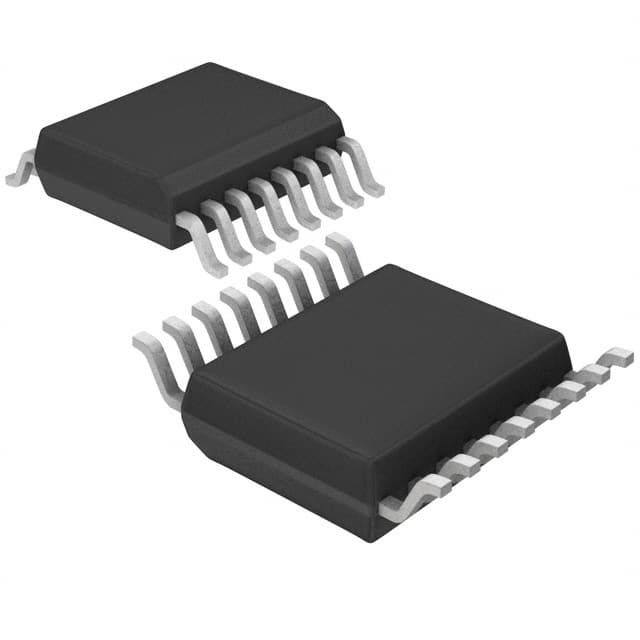Lihat spesifikasi untuk detail produk.

SN74CBT3253CDBR
Product Overview
- Category: Integrated Circuit (IC)
- Use: Multiplexer/Demultiplexer
- Characteristics: High-speed, low-power consumption
- Package: TSSOP (Thin Shrink Small Outline Package)
- Essence: Digital multiplexer/demultiplexer IC
- Packaging/Quantity: Tape and Reel, 2500 units per reel
Specifications
- Number of Channels: 2
- Input Voltage Range: 0V to VCC
- Supply Voltage Range: 4.5V to 5.5V
- On-State Resistance: 6Ω (typical)
- Bandwidth: 200MHz (typical)
- Operating Temperature Range: -40°C to +85°C
Detailed Pin Configuration
The SN74CBT3253CDBR has a total of 16 pins, which are assigned as follows:
- Channel 1 Select (S1)
- Channel 2 Select (S2)
- Enable (E)
- Channel 1 Data Input/Output (I/O1)
- Channel 2 Data Input/Output (I/O2)
- Ground (GND)
- Channel 1 Data Input/Output (I/O1)
- Channel 2 Data Input/Output (I/O2)
- Channel 1 Enable (OE1)
- Channel 2 Enable (OE2)
- VCC (Positive Power Supply)
- Channel 1 Enable (OE1)
- Channel 2 Enable (OE2)
- Channel 1 Select (S1)
- Channel 2 Select (S2)
- VCC (Positive Power Supply)
Functional Features
- The SN74CBT3253CDBR is a dual-channel digital multiplexer/demultiplexer IC.
- It allows for the selection of one of two input channels to be routed to the output.
- The device operates at high speed and has low power consumption.
- It features a wide operating voltage range and can handle signals up to 5.5V.
- The on-state resistance is typically 6Ω, ensuring minimal signal distortion.
- The IC has a bandwidth of 200MHz, making it suitable for high-frequency applications.
Advantages and Disadvantages
Advantages: - High-speed operation - Low power consumption - Wide operating voltage range - Minimal signal distortion - Suitable for high-frequency applications
Disadvantages: - Limited number of channels (2) - Requires external control signals for channel selection
Working Principles
The SN74CBT3253CDBR operates based on digital logic principles. The channel selection pins (S1 and S2) determine which input channel is connected to the output. The enable pin (E) activates the IC, allowing data to flow through the selected channel. The output is controlled by the channel enable pins (OE1 and OE2). When a channel is enabled, the corresponding data input/output pin (I/O1 or I/O2) is connected to the output pin. The IC operates at high speed and consumes low power, making it suitable for various digital multiplexing/demultiplexing applications.
Detailed Application Field Plans
The SN74CBT3253CDBR finds applications in various fields, including:
- Communication Systems: Used for signal routing and switching in communication equipment.
- Data Acquisition: Enables multiplexing of analog or digital signals for data acquisition systems.
- Test and Measurement: Allows for the selection of different test signals in measurement setups.
- Audio/Video Switching: Used in audio/video equipment to switch between different input sources.
- Industrial Automation: Enables signal routing and control in industrial automation systems.
Detailed and Complete Alternative Models
- SN74CBT3257CDBR: Similar to SN74CBT3253CDBR but with 4 channels instead of 2.
- SN74CBT16212ADGGR: 16-channel digital multiplexer/demultiplexer IC with higher bandwidth.
- CD74HC4051M: Analog multiplexer/demultiplexer IC with 8 channels.
These alternative models offer different channel configurations and additional features, providing options for various application requirements.
Word count: 411 words
Sebutkan 10 pertanyaan dan jawaban umum terkait penerapan SN74CBT3253CDBR dalam solusi teknis
Sure! Here are 10 common questions and answers related to the application of SN74CBT3253CDBR:
Q: What is SN74CBT3253CDBR? A: SN74CBT3253CDBR is a multiplexer/demultiplexer integrated circuit (IC) that allows for bidirectional level shifting between two different voltage domains.
Q: What are the key features of SN74CBT3253CDBR? A: Some key features include low on-state resistance, wide voltage range compatibility, low power consumption, and high-speed switching capability.
Q: How many channels does SN74CBT3253CDBR have? A: SN74CBT3253CDBR has two independent channels, allowing for simultaneous bidirectional data transfer between two voltage domains.
Q: What is the voltage range supported by SN74CBT3253CDBR? A: SN74CBT3253CDBR supports a wide voltage range from 1.65V to 5.5V, making it compatible with various logic families.
Q: Can SN74CBT3253CDBR handle analog signals? A: Yes, SN74CBT3253CDBR can handle both digital and analog signals, making it suitable for applications involving audio, video, or other analog data.
Q: How does SN74CBT3253CDBR achieve bidirectional level shifting? A: SN74CBT3253CDBR uses a built-in transmission gate structure that allows bidirectional data flow between the two voltage domains.
Q: What is the maximum data rate supported by SN74CBT3253CDBR? A: SN74CBT3253CDBR can support data rates up to 200 Mbps, making it suitable for high-speed applications.
Q: Can SN74CBT3253CDBR be used in battery-powered devices? A: Yes, SN74CBT3253CDBR has low power consumption and can be used in battery-powered devices without significantly draining the battery.
Q: Are there any special considerations when using SN74CBT3253CDBR with different voltage domains? A: It is important to ensure that the voltage levels of the two domains are within the specified range and that proper level shifting techniques are employed to avoid signal degradation or damage.
Q: What are some typical applications of SN74CBT3253CDBR? A: SN74CBT3253CDBR is commonly used in various technical solutions such as data communication systems, audio/video equipment, test and measurement instruments, and industrial automation systems.
Please note that these answers are general and may vary depending on specific application requirements.

